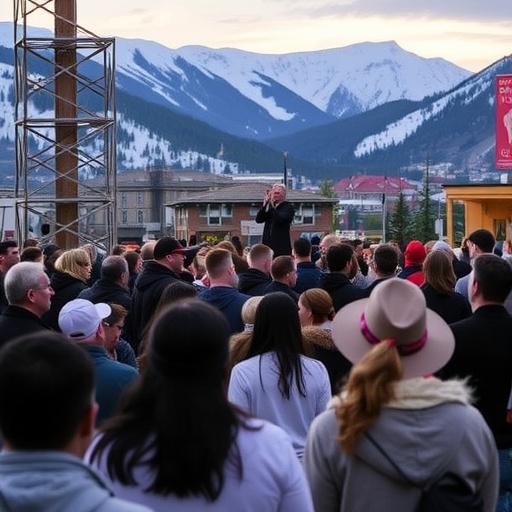Sundance Film Festival Honors Robert Redford‘s Legacy in Emotional Farewell to Park City for 2026
In a poignant blend of celebration and closure, the Sundance Film Festival has announced a heartfelt film tribute to its founder, Robert Redford, as part of its final edition in Park City, Utah, in 2026. Redford, the iconic actor, director, and champion of independent cinema who passed away in September at the age of 89, will be remembered through a series of special screenings, including his directorial debut ‘Downhill Racer’ and restored prints of beloved classics like ‘Little Miss Sunshine.’ This marks not only a tribute to Redford’s visionary contributions but also the festival’s last hurrah in the snowy slopes of Park City before relocating to Boulder, Colorado, signaling a new chapter for the event that redefined filmmaking for generations.
The announcement, made during a virtual press conference on October 15, 2025, by Sundance Institute Executive Director Keri Putnam, underscores the festival’s commitment to honoring its roots amid transition. “Robert Redford didn’t just start Sundance; he breathed life into independent cinema, giving voice to stories that Hollywood often overlooked,” Putnam said. “As we prepare to say goodbye to Park City, this tribute feels like the perfect way to celebrate his legacy while looking toward the future.”
Since its inception in 1985, the Sundance Film Festival has grown from a modest gathering of indie filmmakers into a global powerhouse, launching careers like those of Quentin Tarantino, the Duplass brothers, and more recently, auteurs such as Boots Riley and Ari Aster. Redford’s vision was to create a space where creativity could flourish without the constraints of big-studio interference, a mission that has screened over 20,000 films and awarded more than $50 million in grants to emerging artists through the Sundance Institute. His death from complications related to pneumonia, as reported by his family, sent shockwaves through the entertainment world, prompting tributes from figures like Steven Spielberg, who called Redford “the beating heart of American storytelling.”
This 2026 edition, running from January 22 to February 1, will feature over 100 films, but the film tribute to Redford will anchor the program. Organizers expect attendance to swell beyond the typical 120,000 visitors, drawing fans eager to experience the festival’s swan song in its longtime home. The move to Boulder, announced earlier this year, stems from logistical challenges in Park City, including housing shortages and infrastructure strains exacerbated by the post-pandemic travel boom. Boulder’s selection promises a fresh mountain backdrop with improved accessibility, but for many, it evokes a sense of loss for the festival’s original spirit.
Redford’s Visionary Role in Shaping Independent Cinema
Robert Redford‘s influence on independent cinema cannot be overstated; he was the architect behind the Sundance Film Festival‘s rise as the premier showcase for bold, boundary-pushing stories. Born in Santa Monica, California, in 1936, Redford’s early career as an actor in films like ‘Butch Cassidy and the Sundance Kid’ (1969) and ‘The Sting’ (1973) made him a household name, but it was his behind-the-scenes work that truly revolutionized the industry. In 1981, he founded the Sundance Institute to nurture filmmakers, and by 1985, the festival was born in Park City—a small Utah ski town that mirrored the rugged individualism Redford embodied.
Under Redford’s guidance, Sundance became synonymous with discovery. Statistics from the institute reveal that over 70% of Academy Award-nominated films in the past decade had ties to Sundance, from ‘Moonlight’ to ‘Nomadland.’ Redford personally mentored talents like Nicole Holofcener and John Cameron Mitchell, emphasizing storytelling that captured the human condition. “Sundance was Redford’s rebellion against the formulaic nature of Hollywood,” noted film historian Peter Biskind in a recent interview. “He wanted cinema to be accessible, diverse, and unapologetically artistic.”
Redford’s environmental advocacy also infused the festival; he often highlighted films addressing climate change and social justice, themes that continue to dominate Sundance lineups. His passing leaves a void, but the 2026 film tribute aims to fill it with retrospectives that showcase his multifaceted career. Beyond acting, Redford directed acclaimed works like ‘Ordinary People’ (1980), which won him an Oscar for Best Director, and produced indie gems through his company, Wildwood Enterprises.
The festival’s evolution under Redford included expanding its digital initiatives, such as the Sundance Online platform launched in 2020, which reached 1.2 million viewers during the pandemic. His commitment to diversity grew over time; by the 2010s, Sundance boasted initiatives like the Women at Sundance program, increasing female director representation from 20% to over 50% in premieres. As one longtime attendee, director Ava DuVernay, reflected post-Redford’s death: “Bob Redford saw the future of film in the voices of the underrepresented. Sundance is his eternal gift.”
Spotlight on the 2026 Tribute Screenings and Restored Classics
The heart of the 2026 Sundance Film Festival will be the dedicated film tribute to Robert Redford, featuring a curated selection of screenings that highlight his directorial prowess and the indie films he championed. Kicking off the tribute is a 4K restoration of ‘Downhill Racer’ (1969), Redford’s feature directorial debut, which captured the adrenaline-fueled world of competitive skiing against the backdrop of Colorado’s peaks—ironically tying into the festival’s upcoming Boulder relocation.
‘Downhill Racer,’ starring Redford as an ambitious skier, was shot on location in Aspen and Vail, earning praise for its raw authenticity. Film restorer Todd Sounders, involved in the project, explained: “We spent six months digitizing the original 35mm negatives to preserve Redford’s meticulous framing and the film’s visceral energy. It’s like seeing it anew, with colors popping as if the snow is falling right in the theater.” The screening, set for the opening night at the historic Egyptian Theatre in Park City, will include a panel discussion with surviving cast members and Sundance alumni.
Another highlight is the restored version of ‘Little Miss Sunshine’ (2006), a Sundance breakout that Redford’s festival propelled to Oscar glory, grossing over $100 million worldwide on a $8 million budget. The film’s quirky tale of a family’s road trip resonated with audiences for its unflinching look at failure and resilience—hallmarks of independent cinema. Directors Jonathan Dayton and Valerie Faris will attend to share anecdotes about Redford’s personal endorsement, which included private screenings at his Sundance Resort.
The tribute extends to rare archival footage, including Redford’s keynote speeches from past festivals, and Q&As with filmmakers he supported, such as ‘Reservoir Dogs’ (1992) director Quentin Tarantino, whose debut was a Sundance sensation. Additional screenings include ‘Quiz Show’ (1994), Redford’s exploration of 1950s TV scandals, and ‘A River Runs Through It’ (1992), a lyrical adaptation of Norman Maclean’s novella that won Redford a Golden Globe nomination. Organizers have planned pop-up installations around Park City, featuring memorabilia from Redford’s career, from his Sundance Kid costume to script pages annotated in his handwriting.
To enhance engagement, the festival will offer virtual access to select tribute events, ensuring global fans can participate. Ticket prices for tribute passes start at $150, with proceeds supporting the Sundance Institute’s artist funds. This lineup not only honors Redford but also reminds attendees of Sundance Film Festival‘s role in democratizing cinema, having launched over 200 films that secured distribution deals annually.
Park City’s Bittersweet Last Dance with Sundance
For Park City, the 2026 Sundance Film Festival represents a profound milestone—a final embrace before the event’s departure after four decades of transforming the town into a cinematic mecca. What began as a quiet winter gathering has ballooned into an economic juggernaut, injecting $175 million into Utah’s economy each year through tourism, hospitality, and local businesses. Hotels like the Marriott Summit Watch and Yarrow Hotel routinely book out 18 months in advance, while restaurants see a 300% sales spike during festival week.
Local leaders express mixed emotions about the move. Park City Mayor Nanette Bowman stated in a council meeting: “Sundance put us on the map, fostering a community of artists and innovators. While we’re proud of our role in Robert Redford’s vision, the logistical realities—traffic congestion, housing crunches—have outgrown our infrastructure.” The festival’s growth, from 500 attendees in 1985 to over 120,000 today, strained resources, with recent editions facing criticism over affordable housing for volunteers and filmmakers.
Yet, the film tribute to Redford adds a layer of nostalgia. Community events will include a torchlight parade down Main Street, illuminating screens with clips from Redford’s films, and free outdoor screenings at the Park City Mountain Resort base. Residents remember Redford’s hands-on involvement; he often skied the slopes incognito, chatting with attendees. “Bob was Park City’s quiet guardian,” shared local filmmaker Jenny Livingston. “This last year feels like closing a chapter on our shared history.”
Environmental efforts, a Redford priority, will shine too. The festival aims for carbon neutrality in 2026, partnering with Utah’s clean energy initiatives to offset travel emissions—estimated at 10,000 tons annually. Side programs will feature panels on sustainable filmmaking, drawing from Redford’s advocacy through the Institute of the Environment at the University of Utah.
As the curtain falls on Park City‘s Sundance era, preservationists are pushing to designate festival venues as cultural landmarks, ensuring Redford’s legacy endures in the town’s fabric. The economic ripple effects are clear: post-festival, local arts funding has increased by 40% yearly, inspiring a new generation of Utah-based creators.
Sundance’s Ambitious Relocation to Boulder and Future Horizons
The shift from Park City to Boulder, Colorado, for the 2027 Sundance Film Festival is more than a change of venue—it’s a strategic evolution designed to sustain independent cinema‘s vibrancy in a rapidly changing industry. Boulder’s selection, announced in March 2025, was influenced by its proximity to Denver’s international airport (just 45 minutes away), expansive conference facilities, and a burgeoning creative scene. The University of Colorado Boulder’s campus will host key venues, including the historic Fiske Planetarium for immersive screenings.
Executive Director Keri Putnam elaborated: “Boulder offers the space and spirit to honor Robert Redford’s dream while addressing modern needs like hybrid events and inclusivity.” The move comes amid industry shifts; streaming platforms like Netflix have acquired 30% of Sundance premieres since 2015, prompting the festival to enhance digital components. Boulder’s tech ecosystem, home to companies like Google and IBM, could foster innovations like AI-assisted film restoration—fitting for a film tribute to Redford’s forward-thinking ethos.
Stakeholders anticipate challenges and opportunities. Colorado Governor Jared Polis pledged $10 million in state funding for the transition, boosting local tourism projected to add $200 million annually. Filmmakers like Chloé Zhao, an Oscar winner whose ‘Nomadland’ premiered at Sundance, endorse the change: “Boulder’s natural beauty and diverse community will infuse new energy, keeping Redford’s spirit of discovery alive.”
Looking ahead, the institute plans expanded outreach, including year-round programs in underrepresented communities and a Redford Memorial Fund granting $1 million annually to emerging directors. The 2026 edition in Park City will serve as a bridge, with teaser events in Boulder to build excitement. As Sundance evolves, Redford’s legacy—rooted in authenticity and innovation—promises to guide its next era, ensuring independent cinema remains a force for cultural change.
In the wake of Redford’s passing, this final Park City chapter feels like a collective exhale, blending grief with gratitude. Festival-goers can expect sold-out tributes, lively after-parties at spots like High West Distillery, and conversations that propel the industry forward. Sundance’s relocation isn’t an end but a reinvention, carrying Robert Redford‘s torch to new heights, where stories of resilience and creativity will continue to captivate the world.







